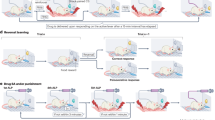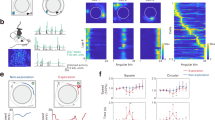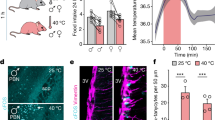Abstract
The lateral hypothalamus is a brain region historically implicated in reward and motivation1,2,3,4, but the identity of the neurotransmitters involved are unknown. The orexins (or hypocretins) are neuropeptides recently identified as neurotransmitters in lateral hypothalamus neurons5,6. Although knockout and transgenic overexpression studies have implicated orexin neurons in arousal and sleep7, these cells also project to reward-associated brain regions, including the nucleus accumbens and ventral tegmental area8,9. This indicates a possible role for these neurons in reward function and motivation3,10, consistent with previous studies implicating these neurons in feeding6. Here we show that activation of lateral hypothalamus orexin neurons is strongly linked to preferences for cues associated with drug and food reward. In addition, we show that chemical activation of lateral hypothalamus orexin neurons reinstates an extinguished drug-seeking behaviour. This reinstatement effect was completely blocked by prior administration of an orexin A antagonist. Moreover, administration of the orexin A peptide directly into the ventral tegmental area also reinstated drug-seeking. These data reveal a new role for lateral hypothalamus orexin neurons in reward-seeking, drug relapse and addiction.
This is a preview of subscription content, access via your institution
Access options
Subscribe to this journal
Receive 51 print issues and online access
$199.00 per year
only $3.90 per issue
Buy this article
- Purchase on Springer Link
- Instant access to full article PDF
Prices may be subject to local taxes which are calculated during checkout



Similar content being viewed by others
References
Anand, B. K. & Brobeck, J. R. Hypothalamic control of food intake in rats and cats. Yale J. Biol. Med. 24, 123–140 (1951)
Olds, J. & Milner, P. Positive reinforcement produced by electrical stimulation of septal area and other regions of rat brain. J. Comp. Physiol. Psychol. 47, 419–427 (1954)
DiLeone, R. J., Georgescu, D. & Nestler, E. J. Lateral hypothalmic neuropeptides in reward and drug addiction. Life Sci. 73, 759–768 (2003)
Petrovich, G. D. & Gallagher, M. Amygdala subsystems and control of feeding behaviour by learned cues. Ann NY Acad. Sci. 985, 251–262 (2003)
de Lecea, L. et al. The hypocretins: hypothalamus-specific peptides with neuroexcitatory activity. Proc. Natl Acad. Sci. USA 95, 322–327 (1998)
Sakurai, T. et al. Orexins and orexin receptors: a family of hypothalamic neuropeptides and G protein-coupled receptors that regulate feeding behaviour. Cell 92, 573–585 (1998)
Chemelli, R. M. et al. Narcolepsy in orexin knockout mice: molecular genetics of sleep regulation. Cell 98, 437–451 (1999)
Peyron, C. et al. Neurons containing hypocretin (orexin) project to multiple neuronal systems. J. Neurosci. 18, 9996–10015 (1998)
Fadel, J. & Deutch, A. Y. Anatomical substrates of orexin-dopamine interactions: lateral hypothalamic projections to the ventral tegmental area. Neuroscience 111, 379–387 (2002)
Baldo, B. A., Daniel, R. A., Berridge, C. W. & Kelley, A. E. Overlapping distributions of orexin/hypocretin- and dopamine-beta-hydroxylase immunoreactive fibers in rat brain regions mediating arousal, motivation, and stress. J. Comp. Neurol. 464, 220–237 (2003)
Harris, G. C. & Aston-Jones, G. Enhanced morphine preference following prolonged abstinence: association with increased Fos expression in the extended amygdala. Neuropsychopharmacology 28, 292–299 (2003)
Harris, G. C. & Aston-Jones, G. Critical role for ventral tegmental glutamate in preference for a cocaine-conditioned environment. Neuropsychopharmacology 28, 73–76 (2003)
Harris, G. C. & Aston-Jones, G. Altered motivation and learning following opiate withdrawal: evidence for prolonged dysregulation of reward processing. Neuropsychopharmacology 28, 865–871 (2003)
Siegel, J. M. Hypocretin (orexin): role in normal behaviour and neuropathology. Annu. Rev. Psychol. 55, 125–148 (2004)
Herrera, D. G. & Robertson, H. A. Activation of c-fos in the brain. Prog. Neurobiol. 50, 83–107 (1996)
Espana, R. A., Valentino, R. J. & Berridge, C. W. Fos immunoreactivity in hypocretin-synthesizing and hypocretin-1 receptor-expressing neurons: effects of diurnal and nocturnal spontaneous waking, stress and hypocretin-1 administration. Neuroscience 121, 201–217 (2003)
Smart, D. et al. SB-334867-A: the first selective orexin-1 receptor antagonist. Br. J. Pharmacol. 132, 1179–1182 (2001)
Bevins, R. A. et al. Novel-object place conditioning: behavioural and dopaminergic processes in expression of novelty reward. Behav. Brain Res. 129, 41–50 (2002)
Wang, B., Luo, F., Zhang, W. T. & Han, J. S. Stress or drug priming induces reinstatement of extinguished conditioned place preference. Neuroreport 11, 2781–2784 (2000)
Campbell, R. E. et al. Orexin neurons express a functional pancreatic polypeptide Y4 receptor. J. Neurosci. 23, 1487–1497 (2003)
Shalev, U., Grimm, J. W. & Shaham, Y. Neurobiology of relapse to heroin and cocaine seeking: a review. Pharmacol. Rev. 54, 1–42 (2002)
Korotkova, T. M., Sergeeva, O. A., Eriksson, K. S., Haas, H. L. & Brown, R. E. Excitation of ventral tegmental area dopaminergic and nondopaminergic neurons by orexin/hypocretins. J. Neurosci. 23, 7–11 (2003)
Georgescu, D. et al. Involvement of the lateral hypothalamic peptide orexin in morphine dependence and withdrawal. J. Neurosci. 23, 3106–3111 (2003)
Trivedi, P., Yu, H., MacNeil, D. J., Van der Ploeg, L. H. & Guan, X. M. Distribution of orexin receptor mRNA in the rat brain. FEBS Lett. 438, 71–75 (1998)
Marcus, J. N. et al. Differential expression of orexin receptors 1 and 2 in the rat brain. J. Comp. Neurol. 435, 6–25 (2001)
Carr, K. D. Augmentation of drug reward by chronic food restriction: behavioural evidence and underlying mechanisms. Physiol. Behav. 76, 353–364 (2002)
Baldo, B. A. et al. Activation of a subpopulation of orexin/hypocretin-containing hypothalamic neurons by GABAA receptor-mediated inhibition of the nucleus accumbens shell, but not by exposure to a novel environment. Eur. J. Neurosci. 19, 376–386 (2004)
Estabrooke, I. V. et al. Fos expression in orexin neurons varies with behavioural state. J. Neurosci. 21, 1656–1662 (2001)
Rodgers, R. J. et al. SB-334867, a selective orexin-1 receptor antagonist, enhances behavioural satiety and blocks the hyperphagic effect of orexin-A in rats. Eur. J. Neurosci. 13, 1444–1452 (2001)
Haynes, A. C. et al. A selective orexin-1 receptor antagonist reduces food consumption in male and female rats. Regul. Pept. 96, 45–51 (2000)
Swanson, L. W. Brain Maps: Structure Of The Rat Brain (Elsevier, Amsterdam, 1992)
Acknowledgements
We thank R. Shiekhattar and R. Smith for comments on the manuscript; and Y. Zhu and S. Aston-Jones for assistance with illustrations and photography. This work was supported by NIH.
Author information
Authors and Affiliations
Corresponding author
Ethics declarations
Competing interests
Reprints and permissions information is available at npg.nature.com/reprintsandpermissions. The authors declare no competing financial interests.
Supplementary information
Supplementary Figure S1
Schematic representations of frontal sections showing the locations of neurons that stained for Fos and orexin. (PDF 174 kb)
Supplementary Figure S2
Low-power photomicrographs of the lateral hypothalamus (PDF 390 kb)
Supplementary Table S1
Orexin-Fos double labelling (DOC 21 kb)
Supplementary Figure Legends
Text to accompany the above Supplementary Figures (DOC 20 kb)
Rights and permissions
About this article
Cite this article
Harris, G., Wimmer, M. & Aston-Jones, G. A role for lateral hypothalamic orexin neurons in reward seeking. Nature 437, 556–559 (2005). https://doi.org/10.1038/nature04071
Received:
Accepted:
Published:
Issue Date:
DOI: https://doi.org/10.1038/nature04071
This article is cited by
-
Unraveling the function and structure impact of deleterious missense SNPs in the human OX1R receptor by computational analysis
Scientific Reports (2024)
-
An ensemble recruited by α2a-adrenergic receptors is engaged in a stressor-specific manner in mice
Neuropsychopharmacology (2023)
-
Preventing incubation of drug craving to treat drug relapse: from bench to bedside
Molecular Psychiatry (2023)
-
Nucleus accumbens circuit disinhibits lateral hypothalamus glutamatergic neurons contributing to morphine withdrawal memory in male mice
Nature Communications (2023)
-
Chemogenetic dissection of a prefrontal-hypothalamic circuit for socially subjective reward valuation in macaques
Nature Communications (2023)
Comments
By submitting a comment you agree to abide by our Terms and Community Guidelines. If you find something abusive or that does not comply with our terms or guidelines please flag it as inappropriate.



